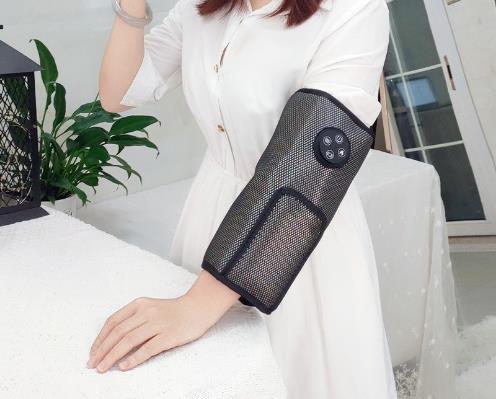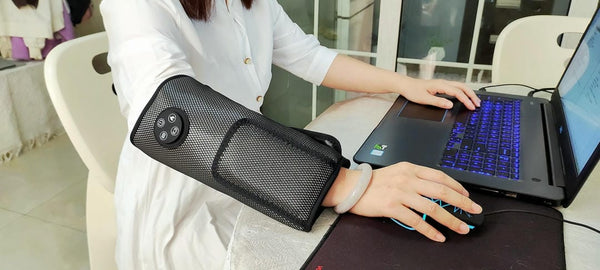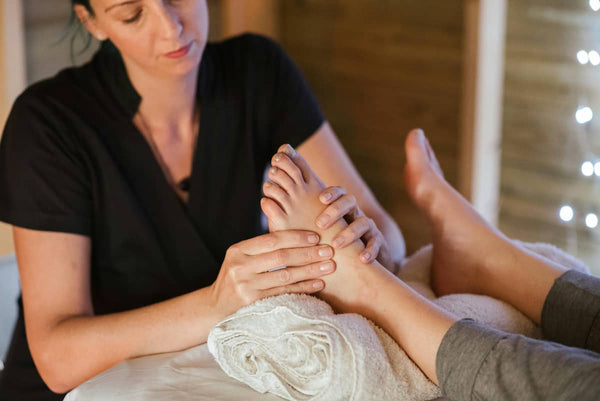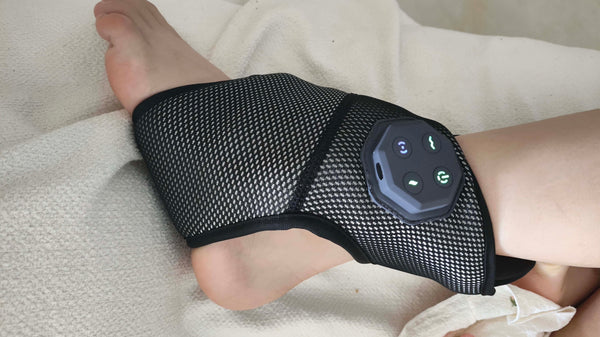If you're an Aussie office worker, you know the drill. Long hours hunched over a keyboard, the endless commute in Sydney traffic, or being stuck in a Melbourne CBD high-rise. Before you know it, a dull ache in your lower back becomes a constant, unwelcome companion. You've tried stretching and promising yourself better posture, but the pain lingers. This leads to the big question: can a back pain massager provide fair dinkum, lasting relief, or is it just a temporary fix?
you're an Aussie office worker, you know the drill. Long hours hunched over a keyboard, the endless commute in Sydney traffic, or being stuck in a Melbourne CBD high-rise. Before you know it, a dull ache in your lower back becomes a constant, unwelcome companion. You've tried stretching and promising yourself better posture, but the pain lingers. This leads to the big question: can a back pain massager provide fair dinkum, lasting relief, or is it just a temporary fix?
Let's be honest, finding time for regular professional appointments can be a nightmare. The idea of having an effective solution at home is seriously appealing. In this guide, we'll dive into whether these devices are worth it, how they work, and what you should look for to get your back feeling sorted. Think of this as your practical roadmap to tackling that stubborn office-induced back pain once and for all.
What's Behind That Nagging Office Back Pain?
Before we look at solutions, it helps to understand the culprit. Most office-related back pain isn't from a single dramatic injury but from the slow, steady stress of poor ergonomics. When you sit for hours, especially in a less-than-ideal chair, gravity and muscle fatigue work against you. Your shoulders round forward, your head juts out, and immense pressure is placed on your lumbar spine and surrounding muscles.
This sustained poor posture forces muscles in your back, shoulders, and even hips—like the deep psoas muscle—to work overtime to keep you upright. They become tight, fatigued, and riddled with painful knots or trigger points. It's a really, really common trap to fall into. This constant state of tension restricts blood flow, leading to inflammation and that persistent ache you feel at the end of the day.
Over time, this can contribute to issues beyond simple soreness, creating a cycle of pain that affects your productivity, mood, and even your sleep. The goal of any effective treatment, whether professional or at-home, is to break this cycle by releasing tension and restoring healthy function. That's where a quality back and shoulder massager can come into play.
How At-Home Massagers Actually Work
Modern back massagers are a far cry from the simple vibrating pads of the past. Today’s advanced devices use a combination of technologies designed to mimic the techniques of a professional massage therapist. Think of muscle knots like tangled headphone cords; a good massager helps gently work them out, and the best ones use multiple methods to do it.
A high-quality heated back massager, for instance, often combines several functions. Advanced Heat Therapy warms up the muscles, making them more pliable and increasing blood flow to the area. This is a crucial first step for effective relief. Then, technologies like Targeted Vibration Therapy can penetrate deep into the muscle tissue to break up adhesions and release that deep-seated tension.
Some of the most effective units, like a modern lumbar massager, also incorporate Dynamic Air Compression. This feature uses inflating and deflating airbags to rhythmically squeeze and release the muscles. This action not only feels great but also helps to flush out metabolic waste, reduce swelling, and deliver a powerful kneading massage experience without the use of hard, unforgiving rollers.
The Real Benefits for Your Aching Back
So, what tangible results can you expect from regularly using a back massager with heat? It's more than just a momentary "feel-good" experience. When used correctly, these devices offer genuine therapeutic benefits that can make a massive difference to your daily life. They are some of the most sought-after back pain relief products for a reason.
- Reduced Muscle Tension: This is the most immediate benefit. The combination of heat, vibration, and compression directly targets and relaxes tight, overworked muscles in the lower back, shoulders, and hips.
- Improved Circulation: Heat and massage both encourage better blood flow. This is vital for recovery, as it delivers more oxygen and nutrients to damaged tissues while helping to carry away inflammatory by-products.
- Increased Flexibility and Mobility: By loosening tight muscles and connective tissues, you can regain a bit of your lost range of motion. This makes it easier to maintain good back support posture throughout the day.
- Convenience and Cost-Effectiveness: Having a portable back massager at home means you can get relief whenever you need it, without the time and expense of repeated professional visits. It’s relief on your schedule, no dramas.
Types of Massagers for Targeted Relief
 Not all massagers are created equal, and the best back massager for you depends on your specific needs. For general massager for back and shoulder tension, a versatile device is key. However, for that deep, persistent ache in your lower back from sitting, a specialised lower back massager is often the best bet.
Not all massagers are created equal, and the best back massager for you depends on your specific needs. For general massager for back and shoulder tension, a versatile device is key. However, for that deep, persistent ache in your lower back from sitting, a specialised lower back massager is often the best bet.
For example, the KLCOSY lumbar massager is a great example of a modern, multi-functional tool. It’s specifically designed to tackle the issues office workers face. It combines Red Light Therapy to enhance circulation, Dynamic Air Compression for a deep kneading effect, Targeted Vibration to break up knots, and Advanced Heat Therapy to soothe stiffness. This combination provides a comprehensive treatment in one device.
Because it's designed to be versatile, it's also effective as a psoas massager or for the abdomen, targeting core muscles that contribute to lower back stability. This versatility is what makes it a standout piece of back massage equipment. It’s not just for your back; it's a tool for managing the entire ecosystem of muscles affected by a sedentary job, making it an excellent option for those seeking the best back massager australia has to offer.
Tips for Using Your Massager Effectively
To get the most out of your electric back massager and ensure you’re using it safely, a little know-how goes a long way. Simply cranking it to the highest setting isn't always the best approach. Give these tips a burl for better, more sustainable results.
- Start Low and Slow: Begin with the lowest intensity and heat settings to see how your body responds. You can gradually increase the pressure and temperature as your muscles get used to the sensation.
- Consistency is Key: A 15-20 minute session each day is far more effective than a marathon one-hour session once a week. Regular use helps prevent tension from building up to crisis levels.
- Target the Right Areas: While you might feel pain in your central lower back, the source could be tight muscles in your hips or glutes. A versatile back massager for hip pain can be used on these surrounding areas to provide more comprehensive relief.
- Combine with Other Habits: A back massage tool is a powerful ally, but it works best as part of a team. Combine its use with regular stretching, getting up from your desk every hour, and focusing on improving your overall posture.
Ultimately, a high-quality back pain massager can be a fair dinkum game-changer for Aussie office workers. By providing targeted, convenient, and effective relief, it empowers you to manage your pain proactively. It's a smart investment in your daily comfort and long-term wellbeing, helping you break the cycle of chronic pain and get back to feeling your best, both in and out of the office.
Frequently Asked Questions
Do back pain massagers provide long-term relief?
They can, but it depends on how you use them. A back pain massager provides immediate relief by relaxing tight muscles and improving blood flow. For long-term benefits, it should be used consistently as part of a broader wellness strategy that includes posture correction, regular movement, and stretching. It's a tool for management and prevention, not a one-time cure. The goal is to keep muscle tension from building up over time.
Can a device like the Klcosy massager replace chiropractic care for hip flexor pain?
A high-quality massager, such as the Klcosy lumbar massager which can also target the psoas and hip area, is an excellent auxiliary tool, but it does not replace professional diagnosis and care. A chiropractor can identify and treat underlying structural issues. The massager is best used to manage the muscular symptoms—like tightness and pain in the hip flexors—between professional appointments and as a way to maintain mobility and comfort. Always consult a health professional for a proper diagnosis of persistent pain.
How to avoid muscle tension imbalance with massager overuse?
This is a great question. To avoid imbalance, focus on symmetry and moderation. Don't just massage the side that hurts; spend time on the opposite side as well to promote balance. Limit sessions to the recommended duration (usually 15-30 minutes) to avoid overworking the muscles. Most importantly, listen to your body. If an area feels overly tender or bruised, give it a rest. A massager should feel therapeutic, not painful.
This reply is generated based on currently verifiable public information. It is recommended to cross-check key content with authoritative sources.




0 comments